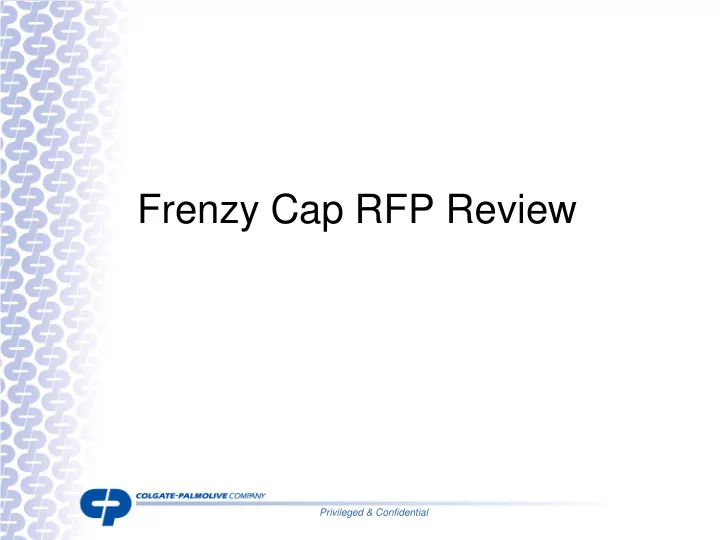

Frenzy Cap RFP Review Privileged & Confidential
Critical Criteria • Understanding of part constraints, risk mitigation • Tool Engineering Concept • Timing / Project Management Systems • Past Experience • Global Capability 2 Privileged & Confidential
Unit Cavity Learning • In Mold Closing not appropriate for this cap • Hinge identified as the cycle limiter • IMC leads to hinge deformation from nozzle-lid interference • Hinge material not set prior to closing • Hinge tension leads to part ovality • Cooling of part is critical • Conformal cooling on cores needed to get to low cycle time • 4 MFI EU resin yields 1750 bar plastic pressure • too high for production tool 3 Privileged & Confidential
Critical Strategy Decisions • Global Vendor • Consistent tool engineering • Shorter capacity tool timing for global roll-out • Single minded approach to tool engineering and design • Streamlined qualification and approval process for additional tools • Streamlined development • Single source development process • Eliminate differing product engineering approaches 4 Privileged & Confidential
Critical Strategy Decisions • Global Vendor • Consistent part quality across regions • Facilitate cross border source / business contingency • Tool movements for capacity reallocation • Global Tech Transfer • Vendor responsible for tech transfer between sites • Global Technical Service • Support CP VI Installations • VI tools the same as outsourced tools 5 Privileged & Confidential
Critical Strategy Decisions • Out of Mold Closing • Out of mold closing deemed necessary for this part • Contrary to some vendor’s approach 6 Privileged & Confidential
Definition of Technical Rating Rating Description Strong demonstration of skills, experience, or systems; detailed evaluations, thorough, wide input 5 of resources, comprehensive proposal, established engineering standards & guidelines, initiates new manufacturing methodologies & best practices, proactive, anticipates potential molding issues, use of computer aided simulation & CAE analysis when applicable. Good demonstration of skills, experience, or systems; good evaluations, multiple resources 4 utilized, detailed proposal, good use of engineering standards & guidelines, fast to adopt new manufacturing methodologies & best practices, likes to try some new ideas before committing, anticipates some potential molding issues, limited use of computer aided simulation & CAE analysis. Average demonstration of skills, experience, or systems; top line evaluations, limited resources 3 utilized, proposal lacks detail, no established engineering standards & guidelines, slow to adopt new manufacturing methodologies & best practices, implementation of new ideas takes time, potential molding issues hard to predict, no use of computer aided simulation & CAE analysis. Weak demonstration of skills, experience, or systems; limited evaluations, one or two resources 2 utilized, little detail in proposal, no established engineering standards & guidelines, slow to adopt new manufacturing methodologies & best practices, needs help with implementation of new ideas, does not know how to link product & tool design to potential molding issues, no use of computer aided simulation & CAE analysis. Poor demonstration of skills, experience, or systems; no detailed evaluations, no resources 1 utilized, little detail in proposal, ad-hoc engineering, difficult to adopt new manufacturing methodologies & best practices, needs help with implementation of new ideas, does not know how to link product & tool design to potential molding issues, no use of computer aided simulation & CAE analysis. 7 Privileged & Confidential
Supplier Technical Rating Product Design 5 4 5 5 3 Review & Depth of Understanding Tool Engineering 5 3 5 4 4 Concept Timing & Project 5 4 4 5 3 Management (Systems) Global Supply 5 1 5 4 5 Capability VI Support at CP 5 2 5 5 5 Facilities Cap Closing 5 3 3 3 5 Concept Weighted 5.0 3.1 4.6 4.4 3.9 Average 8 Privileged & Confidential
Supplier Technical Rating Tool Engineering 5 3 5 4 4 Concept The discussion on tool engineering focused on tool sequence, hinge hold down at mold open, top core movement to release the seal ring inside over cap, optimized cooling for best cycle times, venting, and free & easy ejection of part off hinge insert with out pull or stress to distort or damage hinge. XXXX and YYYYY both demonstrated solid engineering concepts that included two piece steel core construction with conformal cooling. Sequence of the tool included first step of seal ring bead release by movement of a sleeve, and a positive hot side core movement to keep over cap in place in the cavity during mold open until the over cap is off the core. Part is ejected off hinge insert from both sides to ensure quality of hinge. Engineering concept supported their lower cycle time estimates. ZZZZZ original tool concept was different than the other four and had the parting line moved up to the top of the deck and opening of the lid instead of the opening of the base and cavity split of the cap top. This would lead to changes in the part geometry including draft angles and effected the over all feel and look of the part. XXXXX was asked to change their concept and follow the approach established in the two pilot tools. Planning on using beryllium-copper in the core construction for cooling & change in construction added slightly to cycle time, well above known cycle of 35 mm pilot. XXXXX concept does not include conformal cooling of cores and part ejection is only from the base side leaving a high potential for hinge distortion. This point coupled with the 100% inspection of 3,000 caps molded from the pilot tool for bad hinge performance and we are left with the thought their concept is not optimized for hinge quality. XXXXXX concept lacked thought and details. When prompted to potential issues their approach was to make changes to part geometry to address. Was not comfortable with 48 cavities as the first production tool, suggested 32 cavity as the first tool. 9 Privileged & Confidential
XXXXX 10 Privileged & Confidential
Recommend
More recommend